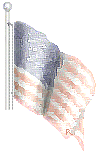Source: The Globe-Gazette, Mason City, 30 Oct 1942
***Update Notes about servicemen added in 2013, per further research. See the updated notes between the separators in the below old news copy from 1942.
![]()
NORTH IOWANS on FAROFF FRONTS;
LARGEST GROUP in IRELAND
THEY GOT THEIR 1ST EXPERIENCE
IN PEARL HARBOR
Have Had Part in All Major Engagements
of Global War
As America’s first wartime Christmas during the second World war approaches, North Iowans at home are daily reminded of their sons, brothers and friends in the armed forces by the service starts which appear in the windows of more homes every day as each navy recruit, each army and marine volunteer, each group of selectees leaves to join the battle forces in all parts of the globe.
With nearly 11 months of the war now a part of grim history, more that 2,000 men from Cerro Gordo county are serving their country, either as seasoned fighting men of the far-flung battle fronts of the world or as determined students in service training schools. Names like Pearl Harbor, Oahu, Bataan, Corregidor, Midway, Coral Sea, Solomon Islands, Dutch Harbor, have taken on a personal meaning for families left at home as their sons learned about war first-hand.
Wherever North Iowans are stationed, they are doing their part nobly and with courage, often beyond the call of duty. Not until the war is over will all the acts of heroism be known. Censorship prevents our knowing or repeating all the stories which will fill a book after the bloody business is finished.
* * *
From every major engagement and every movement of American forces the news comes back of North Iowans who have had an active part. Many had their first taste of battle in the treacherous Jap attack at Pearl Harbor. Frank O. Thomas, former Mason City national guard member, now in the U. S. navy, was cited for bravery in action at Pearl Harbor where he operated a navy crash boat to damaged ships, picking up the wounded and taking them back to safety. Thomas enlisted in the navy in January, 1938.
For heroic and distinguished service against the Japs, Lieut. Paul Knapp, a navy dive bomber pilot, was awarded the navy cross. His ship, the aircraft carrier Lexington, was sunk in the Coral sea battle.
![]()
UPDATE 2013: Lt. Paul Joseph Knapp’s citation War II Navy Cross citation was for scoring two direct hits on the Japanese carrier Shokatu. The citation reads: “The President of the United States takes pleasure in presenting the Navy Cross to Paul Joseph Knapp, Lieutenant, Junior Grade, U.S. Navy, for extraordinary heroism and distinguished service in the line of his profession while serving on board the Aircraft Carrier U.S.S. LEXINGTON (CV-2), in action against the enemy on 7 May 1942, during the Battle of the Coral Sea. His conduct throughout was in keeping with the highest traditions of the Navy of the United States.” He was promoted to the rank of Captain, was the commander of the USS Princeton (LPH-5) during the Vietnam War.
Sources: ussprinceton.info/; homeofheroes.com/members/02_NX/citations/03_wwii-nc/nc_06wwii_navyK.html
[end of 2013 notes]
![]()
A former North Iowan, Col. Joseph M. Colby, was awarded the Order of the British Empire by King George VI of England for mastering innumerable obstacles in tank warfare by his tank design.
Fireman 1st class Lyle F. Ervin, stationed on a submarine in the Pacific, received a commendation from the submarine commander of the Pacific fleet for his part in destroying an enemy freighter and two sampans.
![]()
UPDATE 2013: Brigadier General Joseph M. Colby attended the University of Iowa, completed his undergraduate work at West Point. He developed innovations in tank weapons systems during the 1930’s and 1940’s. His developments were used by the Allied forces during World War II, taking the first American tanks to North Africa. He participated in the design of the M-4 Sherman tank. His influence in tank developments earned him the nickname “Mr. Tank.” After the war he commanded Frankford Arsenal and later was Deputy Commanding General of Ordnance Missile Command, Redstone Arsenal. In 1959, he retired from the Army. He died in 1974.
Sources:
goordnance.army.mil/hof/1980/1988/colby.html
“Guarding the Courthouse Square.” Forest City Summit, Forest City IA. 04 July 2012.
UPDATE 2013: MoMM 1/C Lyle Franklin Ervin served aboard USS Robalo (SS-273) and was lost at sea with the submarine off the Palwan Island, Philippines on July 25, 1944.
[end of 2013 notes]
![]()
A Cerro Gordo county marine who participated in the remarkable stand at Wake island is now presumed to be a prisoner of the Japanese. He is Corp. Lloyd James, son of Paul James of Thornton.

When the United States light cruiser Marblehead was torn by Jap bombs in the preliminary phase of the battle for the Dutch East Indies and limped 13,000 miles to a home port, Melvin O. Whitney, a young Mason City sailor, was among crew members who bailed for days to keep the ship afloat.
Several Mason Cityans have not been heard from since they participated in the battle for Bataan, Corregidor and the Philippines. All are presumed to be Japanese prisoners, although the enemy has not issued a list of men taken in the Philippines. The local men are Capt. Lawrence Meade, Lieut. Lawrence E. Hendrickson, P. F. C. J. D. Cannella of the U. S. marines, Pvt. Thomas Boyle, Pharmacist’s Mate 2nd Class Donald Tapscott, stationed at Cavite; Arthur William Davis, seaman 1st class; Sgt. Ralph Peterson, and Sgt. Ray Wilson.
Gailen E. Dexter, chief storekeeper, a navy career man, participated in the U. S. raids on Jap-occupied Marshall and Gilbert Islands in February.
![]()
UPDATE 2013: Fireman 1/C Melvin O. Whitney, 19, “was one of the brave crew which survived a battle with the Japs [January 24, 1942] as they advanced southward through Macassar strait in their invasion of the Dutch Indies. The Marblehead was ‘bombed to hell,’ as the navy put it, but not only kept afloat but limped 13,000 miles to a home port.” ~ Globe Gazette, Sat., May 09, 1942, p. 8. He died July 23, 1991, and was interred at Memorial Park Cemetery, Mason City, Iowa.
UPDATE 2013: Lt. Lawrence E. Hendrickson died aboard a POW transport ship when it was torpedoed and sank December 16, 1944. PhM 2/C Donald E. Tapscott was liberated from a Japanese POW camp at the end of the war. S1/C Arthur William “Bill” Davis, aboard USS Black Hawk (AD-9) was killed in action February 28, 1942 in the Pacific theater. Sgt. Ralph R. Peterson died in a Japanese POW camp, the Philippines, May 19, 1942. Sgt. Ray Wilson was among the first Japanese POWs to return to the United States.
UPDATE 2013: Gailen E. Dexter survived the war. His mother, Mrs. M. W. Reid of 317 Seventh street N.W. Mason City, was a charter member of the North Iowa Navy Mothers club. She appeared on KGLO’s Forum to talk about “How A Navy Mother Looks At The War.”
[end of 2013 notes]
![]()
A number of local men were active in the fierce battle for Midway island where a Mason City marine, Pvt. William Burke, lost his life [June 4, 1942]. Stephen Smith, a veteran navy pilot, flew a torpedo plane which was struck by 68 navy bullets during the battle. Malvin O. Perkins, master mechanic 1st class, who was injured at Pearl Harbor, also took part in the battle. Other local men there were P. F. C. Laverne Hill of the marines, Edward P. Hand, boatswain’s mate 1st class, and John Jacobs, aviation machinist’s mate 3rd class.
At Dutch Harbor when the Japs attacked the Aleutians was another Mason City sailor, John Shima, gunner’s mate 1st class, who was on leave in Mason City during September.
![]()
![]()
UPDATE 2013: With his instruments damaged in the attack, Ensign Stephen B. Smith returned to the aircraft carrier by flying downwind for about an hour and a half. Awarded the Navy Cross, he was promoted to instructor and was stationed at Fort Lauderdale FL. Among his prized war souvenirs were six bullets that had been removed from the seat of his plane.
UPDATE 2013: MM 1/C Malvin O. Perkins returned to the United States and married Marguerite A. Cave in April of 1943. He filed for a divorce in 1946.
UPDATE 2013: Pfc. Laverne Hill remained in the Marine Corps after the war. He was promoted to the rank of Master Gunnery Sergeant in May of 1961. At this time he was stationed with the 3rd Battalion of the 12 Marine Regiment, 1st Marine Brigade at Kaneohe Bay, Hawaii.
UPDATE 2013: GM 1/C John Shima served aboard the patrol gunboat USS Charleston (PG-51) operating out of Dutch Harbor (Kodiak). She was part of the operations at Attu Island during the assault May 11-13 and May 22. John died July 8, 1954, and was interred at Memorial Park Cemetery, Mason City, Iowa.
USS Charleston Source: en.wikipedia.org/wiki/USS_Charleston_(PG-51)
[end of 2013 notes]
![]()
MACNIDER HEADS GROWING GROUP IN S.W. PACIFIC
Mason Cityan in Alaska, Canal Zone and Other Sectors
The largest contingent of North Iowa men in foreign service at the present time is that in North Ireland, where a large share of the men who left Mason City early in 1941 with the national guard have been sent. The Mason City companies have stuck together to some extent at the Irish bases, although there have been some changes.
Ranking officer in the Irish contingent is Maj. E. O. Babcock.
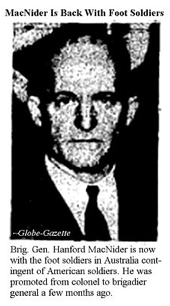
Brig. Gen. Hanford MacNider heads the growing number of men who are known to have been sent to Australia. Formerly connected with the division of supply, he is now back with the foot soldiers.
![]()
UPDATE 2013: Hanford MacNider, a World War I veteran and holder of two Distinguished Service Crosses, served as National Commander of the American Legion. He was an ambassador to Canada in 1930. He was the Republican Vice-Presidential nominee in 1932 and ran for President of the United States in 1940, both which were unsuccessful. He was an anti-war activist until the attack upon Pearl Harbor.
Returning to military duty as a Brigadier General, he led troops in the invasion of the Philippines, earning a third Distinguished Service Cross and a promotion in rank to Major General, and in 1956 was promoted to the rank of Lieutenant General, at which time he declined President Dwight Eisenhower’s offer of a position as a cabinet member. MacNider held three Silver Stars, two Bronze Stars and two Purple Hearts. He died in Sarasota, Florida on February 18, 1968.
[end of 2013 notes]
![]()
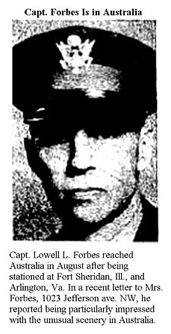
Capt. L. L. Forbes is also in active service in Australia. Lieut. Don Houser, former Mason Cityan, is with the army quartermaster corps in New Caledonia.
![]()
UPDATE 2013: Captain Lowell Lynn Forbes served during World War I, earning the Croix de Guerre. He returned to Mason City and was an attorney. He served as commander of Company F of the Iowa National Guard prior to being called into service in the U. S. Army as a captain in 1942. He was promoted to the rank of Lieutenant Colonel. He died in 1981 and was interred at Arlington National Cemetery.
UPDATE 2013: In 1944, Don Houser was still stationed in New Caledonia with the quartermaster corps. He was promoted to the rank of Captain.
[end of 2013 notes]
![]()
Other Mason Cityans who have sent word of their arrival in Australia are Vann White, Charles Ringus, Max Benowitz, Jarold Rorchart, Gerald Flemming, Richard L. Green, George Honken, Arden C. Lyng, Joseph F. Marlykan, Jack Nutton, Wayne Olson, and Arthur E. Rowe, Jr.
![]()
UPDATE 2013: Pfc. Charles John Ringus, Sr. of the Army died November 28, 1997 and was interred at Elmwood-St. Joseph Cemetery, Mason City.
UPDATE 2013: Arden C. Lyng was promoted to the rank of staff sergeant. After the war he returned to the Mason City area. He died in 1968 and was interred at Oakland Cemetery, Forest City, Iowa.
UPDATE 2013: Jack Nutton died June 9, 2011 and was interred at Elmwood-St. Joseph Cemetery, Mason City.
UPDATE 2013: Pvt. Wayne Olson was wounded on Riak Island in June of 1944 and returned to the United States the following August. He had also served in Italy.
UPDATE 2013 Arthur E. Rowe, Jr. served as a sergeant in the U. S. Army. After the war he returned to Mason City and upon his retirement moved with his wife to Bentonville AR where he lived with his wife on a chicken farm and bred hybrid irises. They later returned to Mason City where he died November 28, 2003. He was interred at Elmwood-St. Joseph Cemetery, Mason City.
[end of 2013 notes]
![]()
Two local men, P. F. C. Richard DeVoe and P. F. C. Cecil T. Woldmoe, have informed their parents of their safe arrival on a South Pacific island. In his letter Private DeVoe said that on the island, where the sun is blistering hot every day, the American forces live on dehydrated food supplemented by vitamin tablets and salt pills. The island is inhabited chiefly by lizards and rodents, he said. The men are kept very busy, he added, and are getting adjusted to the life.
The Mason City men known to be stationed in Alaska now include W. Robert Convoy, Glen E. Mondt, Esten L. Pattschull, who was transferred again recently, Cecil Penney, Roger Bauman (sic) and Sol Benewitz.
In the Canal zone are Roy Lee Bullion, Orpheus Cabbell, Karl Schneider, Joe Korpitor and Charles W. Peters.
Corp. Oresen H. Christensen is stationed at San Juan, Puerto Rico, and Vernett Aldrich, carpenter’s mate 2nd class, is stationed at Guantanamo Bay, Cuba. Corp. Harry M. Ehlers of Plymouth is serving in Trinidad in the British West Indies.
![]()
UPDATE 2013: Richard F. DeVoe was promoted to the rank of 2nd Lieutenant and appointed assistant civilian personnel officer at the Altus Army air field, Oklahoma. Prior to entering the service he was in charge of the Globe-Gazette circulation. ~ The Globe-Gazette, Thursday, August 26, 1943, p. 8.
UPDATE 2013: Cecil T. Woldmoe, promoted to the rank of sergeant, was killed in action March 26, 1944, Bougainville.
UPDATE 2013: Esten L. Pattschull died April 21, 1961 and was interred at Memorial Park Cemetery, Mason City. Pfc. Roger W. Baumann married Dorothy S. Plakonouis January 29, 1944, was discharged from the U. S. Army July 5, 1945, and they resided in Milwaukee, Wisconsin.
UPDATE 2013: Pvt. Karl O. Schneider, serving with the 503rd Parachute troop, died April 21, 1945 and was interred at Elmwood-St. Joseph Cemetery, Mason City.
[end of 2013 notes]
![]()
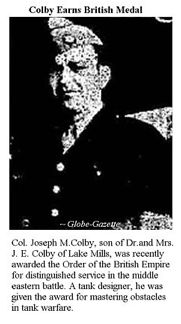
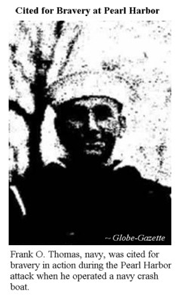
* * *
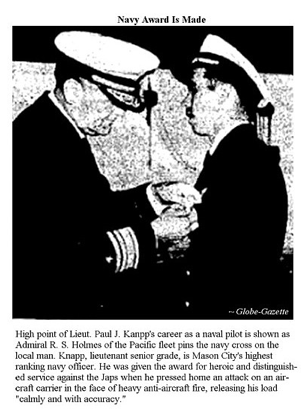
* * *
Survivors of Astoria
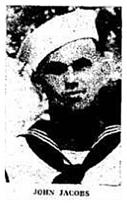
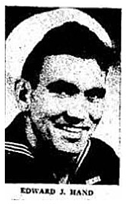
Edward J. Hand, boatswain’s mate 1st class, and John Jacobs, aviation machinist’s mate 3rd class, were members of the ill-fated Astoria, U. S. cruiser which was sunk Aug. 9 in the Solomons while supporting marine landings there. Hand, son of Mrs. Elizabeth Hand, 20 Third street northeast, and Jacobs, son of Mr. and Mrs. Theodore Jacobs, 204 Sixth street southeast spent 30 day leaves in Mason City after the disaster. They had participated in three other major engagements, at Pearl Harbor the Coral sea, and one other in the Solomons.
![]()
UPDATE 2013: USS Astoria (CA-34), during the Solomons campaign at the Battle of Savo Island, came under fire from seven Japanese cruisers and one destroyer on the night of August 8th. She had been hit at least 65 times which resulted in a blazing fire. Consequently, she lost her steering capacity. A bucket brigade bravely fought to extinguish the fires aboard ship, however the Astoria slowly rolled over and sank. All of the men from the salvage crew were rescued by USS Buchanan (DD-484).
Source: en.wikipedia.org/wiki/USS_Astoria_(CA-34)
UPDATE 2013: Edward J. Hand died August 7, 1992 and was interred at Memorial Park Cemetery, Mason City.
UPDATE 2013: Promoted to the rank of Machinist’s Mate 2/C, John Jacobs survived the Salerno heavy bombing of the USS Savannah (CL-42) September 3, 1943. ~ The Globe-Gazette, Monday May 22, 1944, p. 16.
[end of 2013 notes]
![]()
Last Reported in Philippines
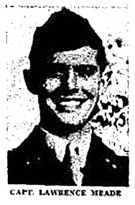
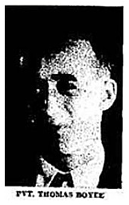
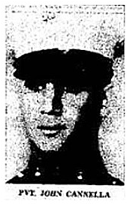
No word has been received from three Mason Cityans who are presumed to be prisoners of the Japanese since the battles of Bataan and Corregidor. Last word from Capt. Lawrence Meade, son of Dr. and Mrs. C. L. Meade, 504 Ninth street southeast, was received in March when it was reported he had recovered from wounds received on Bataan in February. Last word from Pvt. Thomas Boyle, son of Mr. and Mrs. J. J. Boyle, 1424 East State street, was a letter written in January, when he had been moved to Bataan. Pvt. John Cannella, son of Mr. and Mrs. Frank Cannella, 415 Sixth street southwest, was known to be at Corregidor when it fell.
![]()
UPDATE 2013: Capt. Lawrence K. Meade died in a Japanese POW camp, the Philippines on June 16, 1943. Pvt. Thomas Boyle was liberated from a Japanese POW camp at the end of the war. Pvt. John D. Cannella, a Japanese POW held in Manchuria, was liberated after Japan surrendered.
[end of 2013 notes]
![]()
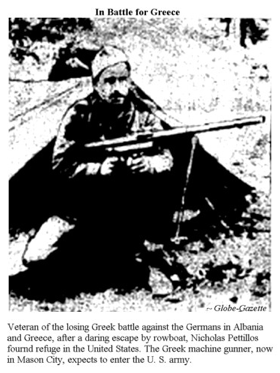
Source: The Globe Gazette, Mason City, Iowa, Friday, October 30, 1942 Page 20 (photos included)
